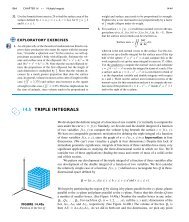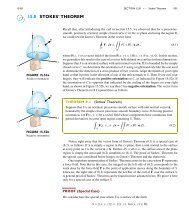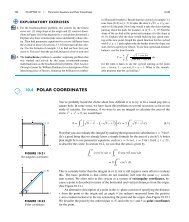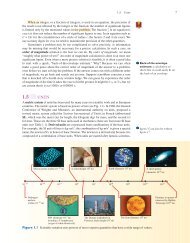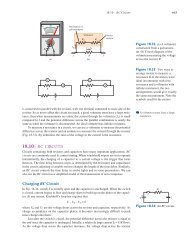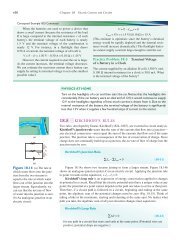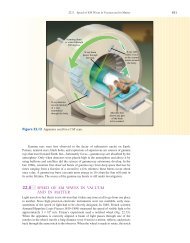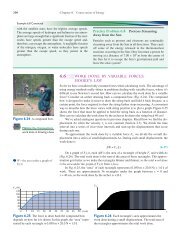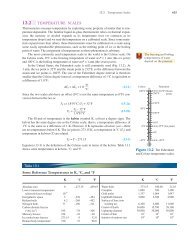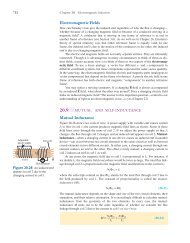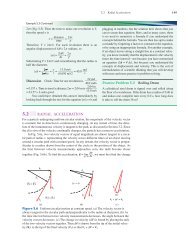Subtracting Vectors Components of a Vector
Subtracting Vectors Components of a Vector
Subtracting Vectors Components of a Vector
You also want an ePaper? Increase the reach of your titles
YUMPU automatically turns print PDFs into web optimized ePapers that Google loves.
3.2 <strong>Vector</strong> Addition and Subtraction Using <strong>Components</strong> 61<br />
Choosing x- and y-Axes<br />
A problem can be made easier to solve with a good choice <strong>of</strong> axes. We can choose any<br />
direction we want for the x- and y-axes, as long as they are perpendicular to each other.<br />
Three common choices are<br />
• x-axis horizontal and y-axis vertical, when the vectors all lie in a vertical plane;<br />
• x-axis east and y-axis north, when the vectors all lie in a horizontal plane; and<br />
• x-axis parallel to an inclined surface and y-axis perpendicular to it.<br />
Example 3.2<br />
An Irish Adventure (2)<br />
In the trip <strong>of</strong> Example 3.1, Charlotte and Shona drive at a<br />
compass heading <strong>of</strong> 27° west <strong>of</strong> south for 18 km to<br />
Kenmare, then directly south for 17 km to Glengariff, then<br />
at a compass heading <strong>of</strong> 13° north <strong>of</strong> east for 48 km to<br />
Cork. Use the component method to find the magnitude<br />
and direction <strong>of</strong> the displacement vector for the entire trip.<br />
Strategy As before, let’s call the three successive displacements<br />
A, B, and C, respectively. To add the vectors<br />
using components, we first choose directions for the x-<br />
and y-axes. Then we find the x- and y-components <strong>of</strong> the<br />
three displacements. Adding the x- or y-components <strong>of</strong><br />
the three displacements gives the x- or y-component <strong>of</strong> the<br />
total displacement. Finally, from the components we find<br />
the magnitude and direction <strong>of</strong> the total displacement.<br />
Solution A good choice is the conventional one: x-<br />
axis to the east and the y-axis to the north. The first displacement<br />
( A) is directed 27° west <strong>of</strong> south. Both <strong>of</strong> its<br />
components are negative since west is the –x-direction<br />
and south is the –y-direction. Using the triangle in<br />
Fig. 3.9, the side <strong>of</strong> the triangle opposite the 27° angle is<br />
parallel to the x-axis. The sine function relates the opposite<br />
side to the hypotenuse:<br />
A x = –A sin 27° = –18 km × 0.454 = –8.17 km<br />
where A is the magnitude <strong>of</strong> A. The cosine relates the<br />
adjacent side to the hypotenuse:<br />
A y = –A cos 27° = –18 km × 0.891 = –16.0 km<br />
Displacement B has no x-component since its direction<br />
is south. Therefore,<br />
B x = 0 and B y = –17 km<br />
The direction <strong>of</strong> C is 13° north <strong>of</strong> east. Both its components<br />
are positive. From Fig. 3.9, the side <strong>of</strong> the triangle<br />
opposite the 13° angle is parallel to the y-axis, so<br />
y<br />
A = 18 km 27° B = 17 km C = 48 km<br />
A A<br />
C<br />
y<br />
B<br />
13°<br />
C y<br />
x<br />
A x<br />
C x<br />
Figure 3.9<br />
Resolving A, B, and C into x- and y-components.<br />
C x = +C cos 13° = +48 km × 0.974 = +46.8 km<br />
C y = +C sin 13° = +48 km × 0.225 = +10.8 km<br />
Now we sum the x- and y-components separately to<br />
find the x- and y-components <strong>of</strong> the total displacement:<br />
∆x = C x + B x + A x<br />
= 46.8 km + 0 + (–8.17 km) = +38.63 km<br />
∆y = C y + B y + A y<br />
= 10.8 km + (–17 km) + (–16.0 km) = –22.2 km<br />
The magnitude and direction <strong>of</strong> ∆r can be found from<br />
the triangle in Fig. 3.10. The magnitude is represented by<br />
the hypotenuse:<br />
∆r = (∆x) 2 + (∆y) 2 = (38.63 km) 2 + (–22.2km) 2<br />
= 45 km<br />
The angle q is<br />
q = tan –1 o pposite<br />
= tan –1 22.<br />
2 km<br />
= 30°<br />
adjacent<br />
3 8.<br />
63<br />
km<br />
Since +x is east and –y is<br />
south, the direction <strong>of</strong> the<br />
displacement is 30° south<br />
<strong>of</strong> east. The magnitude<br />
and direction <strong>of</strong> the displacement<br />
found using<br />
components agree with<br />
the displacement found<br />
graphically in Fig. 3.3.<br />
Discussion Note that the x-component <strong>of</strong> one displacement<br />
was found using the sine function while another was<br />
found using the cosine. The x-component (or the y-<br />
component) <strong>of</strong> the vector can be related to either the sine or<br />
the cosine, depending on which angle in the triangle is used.<br />
Practice Problem 3.2<br />
Coordinate Axes<br />
38.63 km<br />
θ<br />
22.2 km<br />
Changing the<br />
Find the x- and y-components <strong>of</strong> the displacements for<br />
the three legs <strong>of</strong> the trip if the x-axis points south and the<br />
y-axis points east.<br />
y<br />
∆r<br />
Figure 3.10<br />
Finding the magnitude and<br />
direction <strong>of</strong> ∆r.<br />
x



